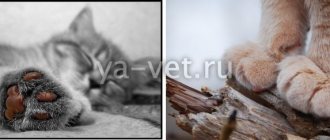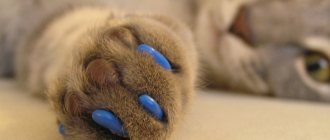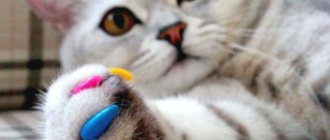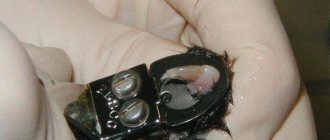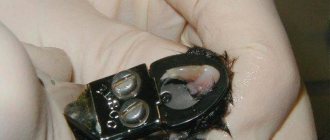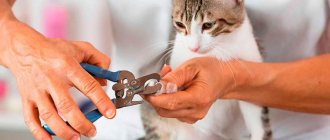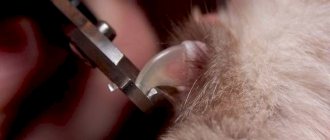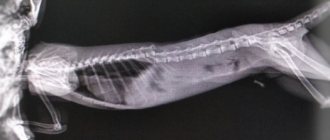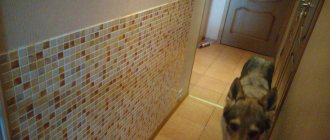Price for “soft paws” surgery for cats at the vet:
| Service | Price, rub |
| Onchyectomy (“soft paws”) on 2 paws | 6000 |
| Onchyectomy (“soft paws”) 1 claw | 700 |
| Anesthesia for a cat during onchyectomy | from 500 |
“ Soft paws for cats , there are scratches on the paws...” In the daily life of their pets, owners of domestic cats are faced with many acute problems that have to be solved one way or another. The fluffy purr needs not only to be fed and treated, but also raised, accustomed to life in an apartment and in a family. Some skills are acquired without problems, while others remain a subject for constant battles. For many owners, the real test was the sharp claws of their pets. Which they grind off on everything, or when playing, leave painful scratches on children and adults. New furniture, new wallpaper can become a new victim for growing claws. And any animal, even the most peace-loving one, is not immune from attacks of aggression or the desire to dig its claws deeper while playing with you or a child.
What to do? Often people are faced with a choice: give the animal away, let it go outside, even euthanize it, or undergo surgery - soft paws for cats. Before you run to the veterinary clinic so that your kitten’s paws become like soft pillows, explain to yourself all the nuances of this surgical intervention, its consequences for cats and the peculiarities of life for pets after surgery.
General information
Onychectomy is not just “cutting the cat’s claws forever”, it is more like amputating the phalanges of the paws.
There are several options for performing the operation:
- Surgical declawing of a cat using a scalpel and scissors under general or local anesthesia.
- Modern method of declawing using laser.
- Separation of connections between tendons and claws. As a result, the cat’s claws will not grow, or, on the contrary, they will grow too quickly, which happens extremely rarely.
Upon completion of the operation, the animal is injected with painkillers and sent home.
TIP: The best age at which the paws will heal as quickly as possible is considered to be up to 1 year, but not less than 8-9 months. At a younger age, they are not yet fully formed, but after that, the nails are already harder.
Why does a cat tear up furniture and wallpaper?
A cat's claws grow continuously, like human nails. Only you and I can take scissors or go for a manicure. Animals have it more difficult. Therefore, in order for a cat to stop spoiling the interior that is dear to the heart and wallet, you need to figure out why she does this.
Zoologists have identified 3 main reasons for scratching surfaces:
- A cat scratches surfaces when it wants to shorten its claws;
- Scratching is a way of marking territory: the cat secretes gland secretions from the pads of its paws. Only cats feel the smell; humans are insensitive to the secretion;
- Scratching helps the animal to remain calm and feel comfortable in its territory.
We have already written that after surgery, many cats stop using the litter box. This is due to the fact that they need to mark their territory. If previously an animal could claim its rights with the help of a secretion in its paws, the smell of which people cannot smell, after onychectomy they do not have this opportunity. But the instinct remains.
The cat begins to mark as best it can. For the owner, it looks like the pet is shitting anywhere.
Advantages and disadvantages of declawing cats
It doesn't take long to remove a cat's claws. But are there any advantages from this? Yes, I have. This is the impossibility of damaging furniture and the absence of scratches on the skin of household members.
But the disadvantages include a number of points:
- anesthesia is not just a dream, but stress for the body;
- the animal is in great pain for a very long time after the operation. The pain is dulled with various painkillers, which is also considered an intervention in the body;
- the phalanx may grow back and require repeated surgery;
- This is real stress for a cat, which not every animal experiences without consequences.
- a cat without claws is defenseless, and any trip outside can end in disaster;
- as a result of onychectomy and a feeling of vulnerability, the pet may use its teeth;
- the pet’s character changes, it may become withdrawn;
- Difficulties with the toilet: sometimes cats refuse to go to the litter box due to the inability to rake;
- the animal will never step on the entire foot completely again in its life, which affects its gait.
Therefore, maybe it’s worth thinking about other options for protecting furniture from cat scratches?
Veterinary clinic services Operation “Soft Paws” (Declawing) - reviews
Martasa
https://otzyvy.pro/reviews/otzyvy-udalenie-kogtey-59981.html
Advantages: The cause of many troubles is eliminated.
Disadvantages: The procedure is not for the faint of heart.
When you get an animal in your apartment, you don’t fully realize all the delights that await you. This happened to me too. We got a smart and beautiful cat, but nothing can be done about animal instincts. She didn’t cause us any particular problems, but torn furniture, torn wallpaper and scratched children were the height of arrogance. Being in the interesting position of expecting a child, I heard about the “soft paws” operation, this is the name of the declawing operation. Without hesitation, I went to the veterinary clinic
UEYU
https://kupi-slona.com/catalog/uslugi-vetklinik-operaciya-myagkie-lapki-udalenie-kogtey-3/557277
It’s hard to even give a rating after experiencing all this! Our cat has been living with us since birth, and in 4 years he has become my son! We love him very much! My daughter is crazy about him! I am writing this in order to understand that we do not use it as a toy or entertainment!
Makeda
https://www.u-mama.ru/forum/family/pets/380382/2.html
Here is almost the first link.
The operation to remove claws (onychectomy) is not very simple - in fact, the cat’s claw phalanges are removed. The operation is performed under general anesthesia. The animal suffers irreparable harm to its health. As a result, the cat becomes disabled. Onychectomy very often leads to complications, such as bleeding, swelling, and blood poisoning. And that is not all. When walking, cats focus only on their toes, and not on the entire foot. Shortening the foot after surgery by just one phalanx of the toes leads to a decrease in the area of support. As a result, the animal cannot walk normally. Uneven load distribution leads to disruption of the entire musculoskeletal system. The load on all joints increases. In the future, there is a high probability of problems with the spine and internal organs. The cat will have to learn to walk again. The sense of balance will be disrupted and this will affect her movements. There have been cases when, after surgery, cats died from painful shock. When an onychectomy is performed by an illiterate veterinarian, additional complications are possible - constant pain in the back and paws, infectious tissue damage, an abscess, and an incorrectly removed phalanx can begin to grow again, which will lead to severe pain. In such cases, a repeat operation and removal of another phalanx is necessary.
After declawing, a cat's character may change. An animal that cannot defend itself becomes angry, nervous and aggressive. It often happens that cats stop scratching and start biting. It turns out that the owner is exchanging one problem for another.
You will have to watch for a long time how, trying to jump somewhere, the cat will not be able to hold on with its paws and will fall to the floor, painfully hitting its muzzle. The spectacle is not for the faint of heart. The adaptation period is very long, and natural instincts will never disappear.
Luxury
https://www.woman.ru/home/animal/thread/4022925/
What did you like so much about yourself that you are now offering to everyone, snake? I did not ask the opinion of moralists, and in no way do I support this operation! And I ask those. those who have already done so, ignore the rest!
Diva
BURN YOU FOR THIS, yay, first, really, remove your nail platinum and you’ll understand how cats tolerate it
Olesya
https://www.babyblog.ru/community/post/petsandcats/1695470
The cat lives happily with us. Furniture? I wrote about a child, a child is more important to me than a cat’s claws, can you imagine!? You have to be completely brainless to put your child’s health at risk for the sake of such inadequate and pitiful reasoning! Why start? I pick up cats and dogs from doorways and on the street that people like you throw away. I sterilize, vaccinate, feed, and take care of them. So I don’t need to be brainwashed with my “good” thoughts.
Pattles
https://otzyv.expert/nuzhno-horosho-podumat-prezhde-chem-sdelat-eto-1477673
Advantages:
furniture intact
Flaws:
one big minus
Details:
and so, let's start with the fact that I am a veterinarian, and strangely enough, I am against this operation! Yes, it’s easier for the owners when the cat doesn’t peel off the wallpaper, doesn’t scratch the furniture, carpets, doesn’t tear you up, but imagine what the cat will survive! Claws are, first of all, protection, God forbid such a cat gets into the street, the percentage of the fact that it can escape from a dog drops to almost 0, since it cannot help but climb a tree or simply punch the dog in the face! But even those cats that never go outside will not be happy that their claws were cut since they are not protected from falling, and since cats love to walk on tops, there is a very high probability of falling from somewhere!, which does not always go unnoticed ! And the operation itself is difficult for the animal, it is difficult to tolerate, the paws are swollen, bleeding, painful! And the doctor does not always perform the operation correctly, which can subsequently lead to the appearance of claws again! Dear owners, I ask you to think carefully before doing this operation, because now there are so many nail clippers, it is enough to trim the claws once a week and there will be no problems, or protective caps on the claws, this will preserve both your furniture and the health of your pet! You can accustom an animal to a scratching post, but it’s not easy, but it’s still possible, I have a Maine Coon and you can’t imagine what kind of claws there are, but we only sharpen them on the scratching post or wear caps!! And no problems!!
Evgesh@. Thinker (8656)
https://touch.otvet.mail.ru/answer/219751115
do not torture the animal... Try cutting off the phalanges of your fingers... (this is the same thing, a very painful and painful procedure for a cat...)
NeZabava
https://www.flylady.ru/fly/viewtopic.php?t=16020
We have a cat. Big, beautiful white cat.
While we are living in the apartment, he tore up all the wallpaper and doors. Sometimes he scratches me, he can scratch his daughter if I don’t see him, and if his daughter offends him.
And now we have a question about moving to a new house. My husband is categorically in favor of “soft paws” - everything in the house is new - doors, plaster, wallpaper (but there is none yet), but I still can’t agree. My heart bleeds, I feel sorry for the cat.
I won’t let him outside - firstly, he is white and washing him after every walk will not bring pleasure to either him or me, secondly, there are fleas - and I am against fleas in a house where there are small children, thirdly, he neutered and very domestic (he has never left the apartment in his entire life), so I don’t think he will go outside.
So I don’t know what to do, my conscience is tormenting me. And time is running out... We're moving in about a month, but after the operation I want to keep him in the apartment, in a familiar environment, so that there is no double stress.
From what they did for the claws - trimming the claws - he managed to scratch the wallpaper with the trimmed ones, even tried to “smooth” his claws with a nail file, all to no avail. He either removes the caps immediately or bites off the tip so that the claws can be released through the cap. She doesn’t accept the scratching post, she’s been lying around in the closet for 3-4 years now, they’ve sprayed her with valerian and other cat remedies - all to no avail - she’ll fall over her, hug her and sleep with her, but she doesn’t sharpen her claws.
Does anyone have experience with “soft paws” surgery? I talked to veterinarians, everyone says that there is nothing wrong and that the cats continue to live in peace, but they make money from this, how honest will they be?
Molly Poe
A colleague has a British woman with her claws removed. The cat was my daughter’s, she had surgery and gave it to her mother “for rehabilitation.” The cat was under severe stress for 2 months, cried, did not run, and now looks more satisfied with life. She did not return to the previous owner) So she settled down “in rehabilitation”, for the second year now. Does not allow himself to be touched by his paws.
Pussicat
https://otzovik.com/review_6546513.html
Advantages:
No torn wallpaper and tattered furniture
Flaws:
No
They write some kind of passion here (everything is fine with us; we had our nails removed a year ago. The first day, and of course, a terrible recovery from anesthesia, but already on the 3rd day, as if nothing had happened, he was playing, running around and everything is fine) there are no violations or aggression) good good cat! walks normally, has not given up the tray. if I think of another cat 100% Soft Paws!
Shpantak-Ann
https://otzovik.com/review_7229539.html
Advantages:
The apartment has all the furniture, wallpaper
Flaws:
no cons
My husband and I bought a British kitten and at that moment lived in a rented apartment. I thought about this operation for a long time, I was afraid for the animal, because I read reviews on the Internet that the cat would remain disabled, the claws would still grow and grow into the pads, he would no longer be able to jump high and far, and would not be able to protect himself. The cat grew up and even though he had a claw sharpener, he still started tearing up the furniture, even in a rented apartment, and the question became whether to give the cat to his parents or have an operation. I really didn’t want to give him away, we got so used to him that we decided to have the claws removed from his front paws, they performed surgery on him, took him away in the morning, and took him away the next day in the afternoon, he was under the supervision of doctors, recovered from anesthesia from them and was returned to us already a normal cat, but he had to wash his paws in vodka or alcohol for 3 days, morning and evening, which he really didn’t like. Although they said that it would be painful for him to jump and walk for the first few days, we didn’t have that, he immediately jumped and ran as if nothing had happened) he was 6 months old when the operation was performed, now he is 2.5 years old, he jumps on top cabinets, the height to which it is physically possible for him to jump. The apartment is full of furniture and wallpaper, and our hands during games)) I don’t regret at all that we decided on “Soft Paws”.
Critic's opinion
https://irecommend.ru/content/myagkie-lapki-eto-khirurgicheskoe-vmeshatelstvo-znachit-nuzhno-kak-sleduet-podumat-tak-li-ne
For a long time I could not decide on this operation. I put everything off until later - I felt incredibly sorry for the cat...
But the question arose:
- Or the cat moves with us to another city to a rented apartment, where no one will tolerate damage to furniture and wallpaper, like at home (we are already replacing the second sofa in 4 years),
- Or you will have to give it to your parents, friends,
- Or... that's where the thought stopped...
Looking through a bunch of reviews about the “soft paws” operation, I was convinced that mostly those who don’t have cats say negative things! I can understand them, what advantages can you find if you only see the suffering of an animal?
*********I would love to see the look on your face when the cat starts tearing up your fresh textile wallpaper! And what you will do to her in reality after this.************
***But, back to the topic... The day of the operation***
The day before the operation, the veterinarian told me to feed the cat in the evening and remove the bowl, and not give anything to eat in the morning.
As a result, in the morning, while I was getting ready for work, a “tail” followed all family members everywhere, begging for food and faithfully looking into their eyes. This was a turning point. I feel sorry for my favorite one. And because she’s hungry, and because you understand what’s in store for her, but she doesn’t...
Next I am writing from the words of my husband...
It was difficult to get it into the carrier. The cat realized that “something was wrong” and became quick, so I had to tinker!
A friend works at the veterinary clinic and told her to leave Our Dasha and come in about 2 hours. But the operation ended earlier and my husband received a call about an hour and a half later. By the time my husband arrived at the veterinary clinic, Dasha had already begun to recover from the anesthesia.
_____________***At home we were able to observe all the wonders of balancing act!*** ______________
The cat didn’t want to sit still, she walked staggering around all the rooms, constantly falling and looking for corners (which looked very strange):
- Dasha found some corner;
- She poked her muzzle into him and fingered him with her paws;
- Apparently, it seemed to her that it was walking somewhere...
Also, she was terribly cold, probably because of anesthesia her body temperature drops (at least it was the same during sterilization).
The postoperative period is coming to an end
The operation was performed from approximately 11 to 12.30. The family was able to watch Dasha for up to three hours, they controlled her. They removed the chairs she crashed into and blocked the path to the radiator where Dasha wanted to warm up.
But when they left, the cat was able to get to the battery and burned her entire face!
I saw her in the evening, Dasha looked like Joan Watson from the series “Elementary” - slanted almond-shaped eyes and ruddy (from a burn) cheekbones.
They smeared panthenol on the burns and examined the paws. She let them look at them without any problems, maybe the painkiller they injected her was still working? They didn’t wrap our paws, they just treated us with some kind of antiseptic silvery thing. Hard threads stick out in place of the claws.
- In general, the cat looked lethargic, sleepy, and tired.
- She ate poorly, but she was still able to eat sausage from her hands. I drank water, but not much.
- By evening she was already jumping onto our sofa, and once she jumped off herself. I don’t know who was more scared by this jump: the cat or me.
But I tied a scarf around me and carried Dasha in it (probably the feeling of guilt got the better of me). And she didn’t resist. You lay there contentedly - warm, good, they stroke you and carry you everywhere with them.
In the evening, the cat fell asleep on the sofa, like a king - in a pile of rugs and blankets. They didn’t drag her, they put her next to the sofa, on the floor, with sofa cushions for Dasha to climb down on them. But she never got up during the night.
On the second day they didn’t bother with her like that anymore. And the cat confidently stepped on its paws. True, they still didn’t let her jump from above; they tried to take her down to the floor themselves.
That day Dasha began to pull the threads out of her paws. And since the cat has bad teeth (as we were told, her gums are inflamed), we treated her oral cavity with a solution of furatsilin, otherwise she would get an infection and her paws would become inflamed...
***Generally***
- The operation is scary... for cat owners. It’s hard to cope with feelings of guilt and pity for your pet...
- I did not observe the suffering of the animal itself - the cat did not scream in pain and quickly recovered.
- But still, “soft paws” are a surgical intervention. This means that you need to think carefully about whether surgery is really necessary?
Here is our result on day 10 after surgery:
Thanks for any comments! I perceive serious attacks only from owners of “scratching” cats, and not from outside observers...
Alexa_R
https://irecommend.ru/content/ne-tak-strashen-chert-kak-ego-malyuyut-83
I’m looking forward to throwing slippers, but... I read somewhere an opinion that this operation, or rather the owners who decided to do it, are cursed by those who don’t have cats. Perhaps this is true. Let me make a reservation right away that in no case do I recommend and, moreover, do not encourage anyone to undergo this operation; everyone decides for themselves, since the matter is really not a joke.
As usual, I'll start with some background. We have a new family member, a little kitten. And the larger this miracle grew, the more aggressive it became. Unfortunately, his character turned out to be such a difficult one. I was ready for peeling wallpaper, jambs and an unhealthy love for furniture, since I lived with cats all my childhood, but I was not prepared for the fact that the cat would throw itself at everyone with the obvious goal of maiming. He attacked my husband and me when we were sleeping, mostly grabbing our faces. I often walked around with scratches either on my forehead or on my cheek. The child was afraid to leave the room in the evenings, as the cat regularly attacked him with its claws. My husband’s friend, who came to visit us, had his vein torn so that the food stopped bleeding. In general, our mustachioed friend behaved extremely undignified. The question became more pressing when I became pregnant with my second child. Realizing that if a cat attacks a newborn in the same way, trouble will not be far away. We contacted the veterinarian, he prescribed Api-San Stop Stress calming drops for the cat. You can read a more detailed review about it
Here . I can only add that the drops did not solve our problem. And so, when there was no time to wait for changes in his behavior, we decided to remove the claws.
They took the cat to the clinic at 10 a.m. and picked him up at 5 p.m. After anesthesia, he counted all the angles; he did not want to lie still. Therefore, I had to sit with him and not let him wander around the apartment again. The paws were tightly wrapped, which caused discomfort in the cat and he stubbornly tried to remove the bandages. By morning, the anesthesia wore off completely, I had more strength and the bandages were removed. The first day we fought with the cat about this. We bandage it, he takes it off and starts gnawing on the stitches. The problem was solved in the following way: I cut off the children's tights, put them on the paws, and tied them in front and at the top. The cat was happy with this and calmly ran around the apartment in them.
4 days after the operation they gave painkillers, the cat behaved calmly, so I do not share the opinion that the animal is in pain. Two weeks later the stitches were removed. The cat feels great. He also climbs cabinets, doesn’t fall from anywhere, and strokes his scratching post out of habit. But some changes did occur, oddly enough, he became more affectionate, purrs, rubs. Now my son and I are chasing balls around the apartment, and after putting my two-month-old daughter to bed, I’m not afraid to leave the room and leave her alone with the cat.
This was our example of performing declawing surgery on a cat, and again, I do not encourage anyone to do the same. Everyone must weigh the pros and cons for themselves. The only thing I want to emphasize for those who may not be aware. This procedure is only suitable for domestic cats! If your pet periodically walks outside, just randomly runs out while you are closing the door, or you plan to take the cat with you to the dacha in the summer, you should under no circumstances remove its claws. This is their protection in the outside world. And yet, if you finally decide, do not forget to study the reviews about this operation in the clinic of your choice. Still, the qualifications of the personnel also play an important role.
And finally, a photo of my peacefully sleeping cat. It shows the front paw in all its glory. The brilliant green has not completely washed off for a couple of months, but the paw itself looks absolutely no different from the “clawed” one.
Purpose of Cat Declawing Procedure
In most cases, owners decide to remove cat claws because the animal begins to damage interior items. Agree, not everyone can accept the loss of their favorite leather sofa, beautiful wallpaper and other expensive things.
Another reason, and it is more significant, may be aggression towards other animals, children and household members. But is it worth resorting to such radical methods of solving the problem? You need to start from the very basics. You should first try to raise your cat using primitive methods. For example, punish for damaged property, using various ways to show that such behavior is unacceptable.
If you couldn’t come to an agreement with your cat, then you should try to purchase special care items, such as a scratching post. Don’t forget that scratching posts are also different and before you give up, you should try several of their options, because not every one may suit your furry beauty’s taste.
Among other things, it is better to accustom your animal to trimming its nails from a very young age. This manipulation should be carried out approximately every 3-4 weeks, this can also protect your property from damage.
If none of the above methods helped you, then you can use a device called “anti-scratch.” These are caps that are put on the claws and attached with special glue. They do not last forever and require periodic replacement as needed.
At what age can a cat be declawed?
Owners who are thinking about having a cat declawing operation are concerned about the question of when they can start the procedure. But before taking such extreme measures for cats who have the opportunity to walk, take into account that the animal will remain defenseless.
A kitten should not have its claws removed: their soft scratches do not cause harm; the body continues to form. In addition, it is absolutely cruel to subject a child to such stress.
According to the veterinarian’s recommendations, declawing surgery is performed on a kitten no earlier than 6-7 months. But it would be better to do it within a period of eight months to a year: the cardiovascular system has already become stronger, and the cat will have to get used to the consequences of walking without claws and adapt again in life situations. Therefore, if the owner has already decided to take such measures, then there is no need to delay and wait - in the absence of serious medical contraindications, the operation is easier to tolerate at a young age.
What is soft paw surgery?
Onychectomy is a surgical procedure to remove a pet's claws. Popularly, the procedure has the pleasant name “soft paws”, but in fact it is a serious test for the cat. During the manipulation, the veterinarian removes not only the transparent plate with a sharp end, but also the entire claw phalanx (part of the finger). The operation is performed in a clinic under general anesthesia.
Any surgical intervention in one way or another affects the physical and psychological state of the animal. Unlike most surgical procedures, the soft paw procedure is often performed only at the whim of the owner and is not aimed at saving the life and health of the animal.
Pet owners can choose more humane ways to deal with the problem of sharp nails. Among them:
Cat claw covers
- painless trimming of nails twice a month using a special nail clipper;
- purchasing silicone stickers;
- buying a scratching post.
Indications for surgery
There are no absolute indications for “velvet paws” surgery. An owner who agrees to get rid of his pet’s sharp claws once and for all must understand the seriousness and danger of this procedure.
Relative indications for surgical intervention of this kind can be considered:
- exceptionally aggressive nature of a pet that cannot be trained;
- unsuccessful attempts to train an adult pet to sharpen its claws in a specially designated area;
- regular attacks on small children living in the same house with a cat;
- fungal disease of the claw plate in an advanced stage, which is difficult to treat;
- seizures of epilepsy (claws are removed so that during an attack the animal does not injure itself or a person);
- abnormal ingrowth of claws into the fingertips, deformation of the claw phalanx.
Contraindications to amputation of claws
It is strictly forbidden to perform the “velvet paws” operation on cats leading an outdoor lifestyle. Without claws, the animal becomes defenseless and will not be able to climb a tree or protect itself from attacks by stray dogs.
It is highly undesirable to perform onychectomy on cats living on the upper floors. It is known that they love to walk on the balcony and hunt for birds. Without claws, a cat is defenseless; it will not be able to catch on to the railing when falling from a height.
Also, any surgical interventions are contraindicated in cats who are allergic to anesthesia. The consequences of an allergic reaction can be serious, including death.
What to do instead of surgery
Veterinarians and zoologists have long understood the problem and found solutions that can help avoid surgery and keep the interior intact. To protect yourself from scratching, you can use safe methods designed for cats:
- Trimming the dead sharp tips of the claws. This will reduce the need to regularly sharpen the claws on all accessible surfaces.
- Silicone stickers on claws. They are attached with special glue like false nails. Protect the owner from injury. But the animal does not lose the ability to slow down in a jump and secrete a secret to mark its territory.
- Training to use a scratching post. Sometimes a cat just needs to sharpen its claws for peace of mind. Such is the nature of a cat. Just show your pet where it can be done: the same way you trained it to use the tray.
All methods are painless and harmless to the cat and do not cause discomfort. If you spend a little more time on your animal, you can easily do without a mutilating and dangerous operation.
Veterinary doctors do not perform onychectomy or soft paw surgery. But if your cat scratches, contact us for a consultation. We will find the cause of the problem and help you fix it.
How is the operation soft paws for cats performed?
If you have made a conscious decision to have a soft paw surgical procedure, it is important to find a good veterinarian who will competently and skillfully perform this operation. It is usually performed under general anesthesia. No one “rips out” the claws, the doctor carefully removes them using special tools, the pillows are not injured, sutures are placed on the incisions, it is better if they are absorbable. The paws are bandaged to protect them from bleeding. Additional medications may be prescribed to help the cat recover better from anesthesia.
But my cat scratches
In many countries, onychectomy is prohibited. In Russia, a ban on cutting off part of a cat's paw has not yet been introduced. But humane veterinary doctors in the Russian Federation do not carry out the procedure, since there are no direct indications. Finding good specialists who will perform the “soft paws” operation in St. Petersburg is almost impossible.
Scratching isn't the only problem. It is worth remembering that a cat not only scratches, but also bites. A bite is much more painful than a scratch. Therefore, the owners will not be able to completely rid themselves of injuries.
So what makes us bring our pet to the clinic? Is this really a necessity or more of a false security imposed by society? Let's try to determine the root cause of the problem to understand whether it is possible to do without surgery.
Description of declawing surgery
Onychectomy is banned in a number of European countries.
Local anesthesia is sometimes used for the operation, but general anesthesia is more often used.
The claws are removed entirely from the first phalanx of the finger. A suture and anesthetic ointment are applied to the damaged area. Then the paw is bandaged, and a collar is put on the cat’s neck, which will protect the seams from licking.
Along with the application of anesthetic ointment, auxiliary injections are administered.
Post-operative cat care
Usually after 6-10 hours the cat can already move independently. It is recommended to keep an eye on her for at least a day or two until she completely recovers from anesthesia; this time is individual for each animal. Veterinarians recommend providing the animal with a comfortable bed on the floor, limiting walking and jumping in the first hours after surgery, and not allowing jumping from a height.
A day or two after the operation, the paws may bleed, and the cat will feel uncomfortable stepping on them, but within 10-12 days everything should return to normal, and the cat will continue to run, play and jump on cabinets.
Postoperative care
After the operation, the animal is put on a collar, which will help avoid licking the stitches.
Typically, recovery after surgery takes about 1 month. During this period, pet owners will need to clean the stitches every day with an antiseptic solution prescribed by a veterinarian. The cat needs to be put on a special collar, which is attached to the neck and prevents it from licking the seams. The animal will need to wear a collar until they are removed. Mostly, stitches are removed 2 weeks after the “soft paws” operation.
To reduce the likelihood of infection in the body, the veterinarian prescribes antibacterial medications. It is not recommended to use regular toilet filler. Veterinary doctors from the Zoovet clinic advise placing torn paper in the tray. In addition, the owner will need to carefully care for the cat until it adapts to new living conditions. Care and attention and playing with your pet will help reduce stress from the procedure.
Rehabilitation of cats after onychectomy
When the cat's claws are removed, the process of recovery after surgery begins, both for the condition of the paws and for the entire body. Fluffy needs the caring attitude of the owner.
There are a number of nuances for caring for a cat:
- pain relief in the form of injections, if necessary;
- daily treatment of wounds;
- the dressing needs to be changed regularly;
- A visit to the doctor is recommended once a week.
The cat is really looking forward to its owner's love and care, only in this case it will get better sooner.
The recovery period after surgery lasts a month. During the first few days it is painful for the cat to stand on its paws; it will be hampered by pain and discomfort. Then the walking process gradually improves, but the cat may limp.
It is better to remove the cat's claws first on the front paws and then on the back paws. One by one deletion is allowed. This requires expert advice.
Possible complications
There are many negative effects after an operation called “soft paws”. The experience and professionalism of the veterinarian plays a big role - violation of the surgical technology entails a risk of infection. Also, if the soft tissues do not heal properly, the cat may experience discomfort when walking, resulting in changes in the animal’s gait and posture.
Consequences of declawing a cat
The results are the most disappointing. Interfering with the structural integrity of a cat’s body, in fact, makes the cat disabled.
In this case, the torment begins the moment the patient wakes up from anesthesia. The poor things are not feeling well. Requires careful care. Nausea and vomiting, increased body temperature and rapid heartbeat are observed. If you are allergic to the components of anesthesia, the outcome can be fatal.
The recovery period lasts at least a month and is complicated by severe pain.
Wounds require daily thorough treatment (washing, applying healing agents, changing the bandage). To avoid tearing off the bandages and injuring the paws, a protective collar is put on the patient, which causes a lot of inconvenience to the already unfortunate creature.
Regardless of the type of anesthesia, the animal experiences severe pain after surgery.
The first days after the operation the animal refuses to eat and does not move. After 5-8 days he takes his first steps, causing physical suffering. The vestibular apparatus undergoes dramatic changes, including when distributing the load. Purr is learning to walk again.
Consequences and complications
Let's look at the complications caused by merciless surgery:
- pathologies of the musculoskeletal system (impaired coordination of movement, falling on paws, changes in gait);
- joint damage (arthritis) caused by load changes;
- purulent infections of bone tissue (osteomyelitis);
- curvature of the spine caused by newly acquired defects (the operated pet steps on the entire foot when walking and running, a healthy individual only on the toes);
- muscle atrophy.
At the same time, the following disease processes are observed:
- bleeding from the wound surface;
- decreased resistance to diseases;
- deformation of nerve endings, in which every step, even after external wound healing, causes pain;
- development of urolithiasis;
- ingrown claw (the stratum corneum remaining after poor-quality treatment grows inward, causing inflammation);
- blood poisoning;
- injuries received by a crippled creature as a result of loss of its former balance;
- dysbiosis and other changes in the digestive organs caused by the consumption of antibiotics necessary for the speedy healing of wounds.
At the same time, onychectomy traumatizes the psyche.
Declawing causes damage to a large number of nerve endings
The pet becomes fearful, aggressive and withdrawn. Instead of claws, she uses her teeth, including without reason (when a person tries to approach her).
Some specimens stop relieving themselves on the tray because they cannot rake up the litter in order to bury excrement. Social life becomes more complicated. Warriors become vulnerable on the street. They may die from the teeth of relatives or dogs.
Relationships with the opposite sex worsen. Love games lose their charm due to the impossibility of giving a slap in the face, which is characteristic of this process.
Amputation leaves an indelible mark on a kitten. Experienced fear, pain and inconvenience make the baby angry, unsociable and antisocial.
Unfortunately, there are currently many supporters of cruel surgery. It seems to them that the procedure will not harm their beloved kitty.
Since ancient times, pulling out people's nails has been equated to torture. This is worth thinking about!
Contraindications and consequences for cats
One of the main contraindications to the manipulation is to take the cat outside for walks, as the cat may be injured after the procedure.
Surgical intervention is not resorted to in situations where the pet leads a street lifestyle. As for postoperative complications, the intervention can cause stress in the cat. Animals feel defenseless, so changes in their behavior are often observed. Pets may prefer to be alone, avoiding contact with their owners. The opposite situation can also happen when the cat becomes aggressive and lets in a second weapon - teeth.
After the operation, the cat is no longer as dexterous as she was before. Now she cannot stay on vertical and slippery surfaces in the usual way.
In addition, anesthesia, even gentle, does not benefit the body of pets, but vice versa. The animal leaves him for about a day. The rehabilitation period does not always go well; sometimes the animal experiences pain for a long time while walking. The possibility of wound infection cannot be ruled out. This is especially true in situations where the operated paw was not bandaged or the owner does not follow the recommendations for postoperative care.
There are cases of changes in gait, as well as loss of coordination of movements. These complications are caused by a decrease in the support area. After surgery, the cat is forced to step on its feet instead of its toes. Diseases of the musculoskeletal system can also develop. After soft paw surgery, the load may be unevenly distributed, which is why curvature of the spinal column or osteomyelitis sometimes develops.
Alternative to Declawing
There are options in which the risk to your pet’s health is minimized.
Trimming
Murka is fixed so as not to damage the limbs. If necessary, bring in an assistant. Using forceps with rounded ends, carefully cut off the overgrown stratum corneum (no more than one millimeter). The use of scissors is not recommended. Manipulations are fraught with cuts. The structure of the plate is damaged.
Using special stickers
The best way. Non-toxic glue developed by veterinarians is applied to the claws, onto which silicone stickers of the appropriate shape are fixed. Harmless, available in different colors.
The stickers are effective for a month. Good for long-term use.
Gluing silicone caps to the cat's claws
